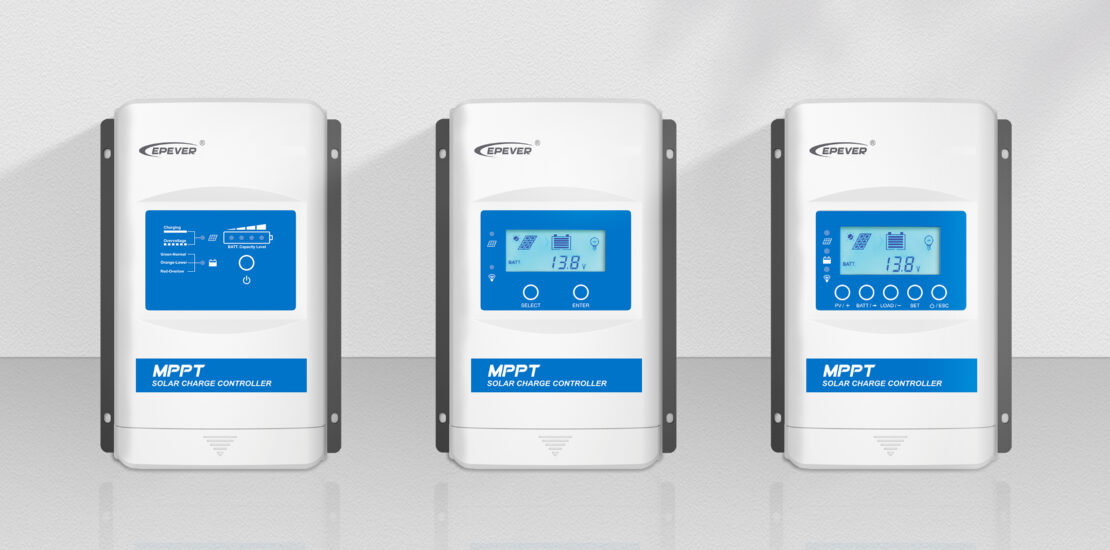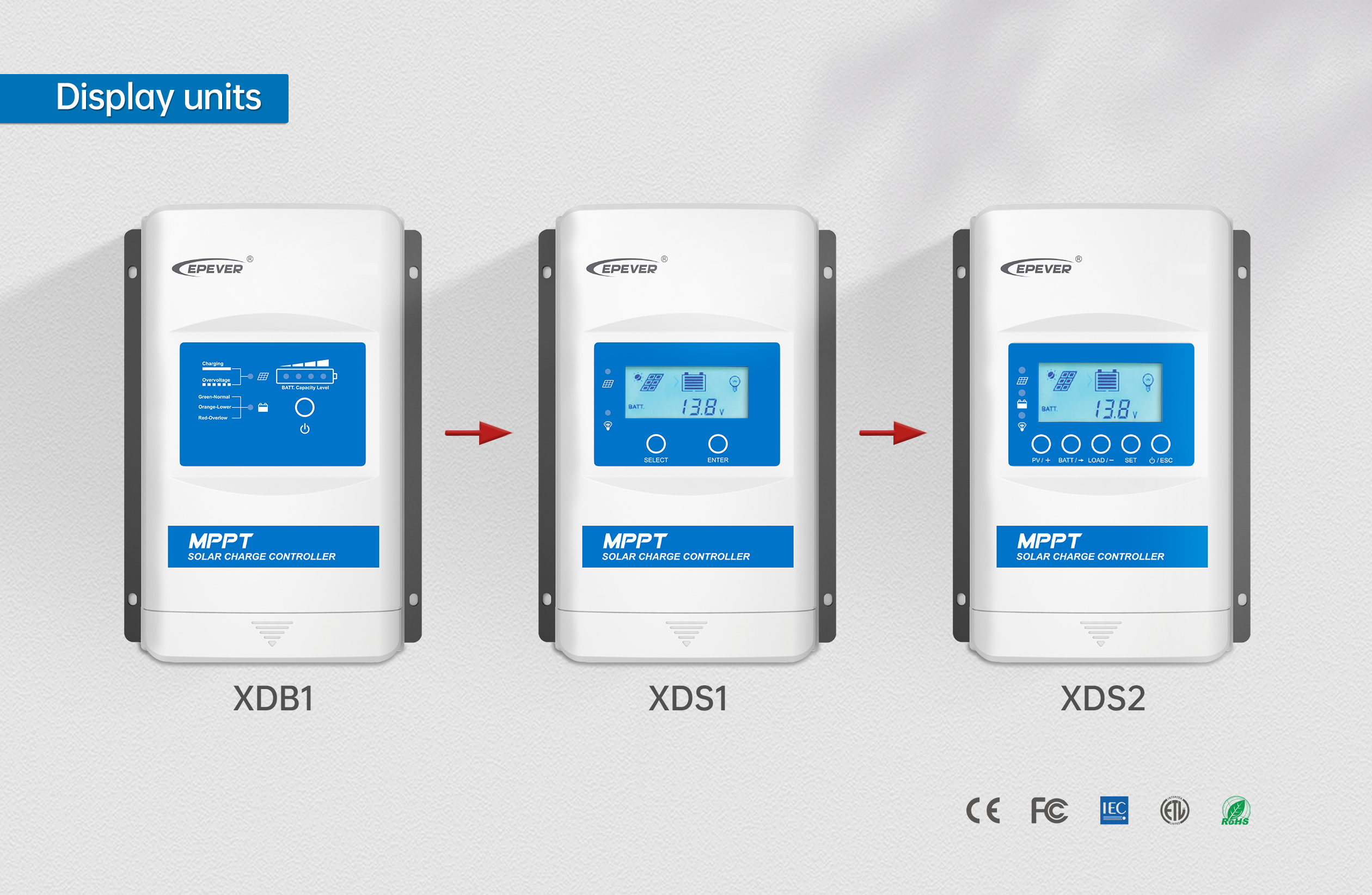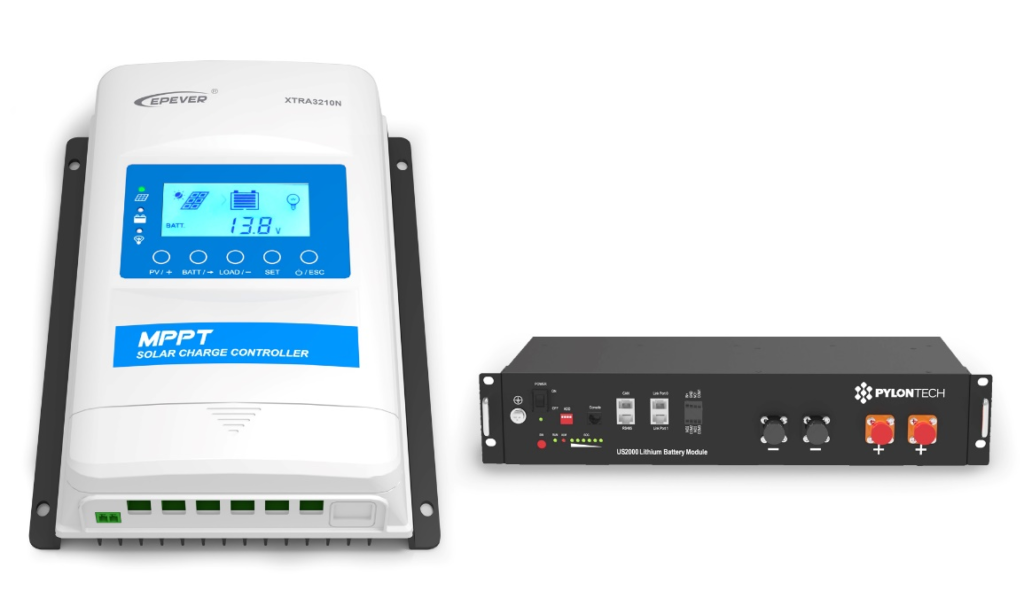- July 27, 2022
- Category: EPEVER
- 5847 views

An Introduction to EPEVER XTRA series
There are numerous series of solar charge controllers on the market. The technology is the state of the art, and most of the well-known high-tech brands deliver high-quality charge controllers.
Indeed, selecting among the charge controllers is more of a matter of application and features nowadays. The wide range of off-grid applications has urged manufacturers to provide tailored solutions.

In this article, we will look at the EPEVER XTRA series charge controllers, which is a “general purpose” solar charge controller, and being lithium-friendly makes it distinctive.
XTRA is an MPPT charge controller, which simply means that it matches the output of solar panels to the battery voltage to ensure the highest efficiency possible. The maximum charge and discharge capacity are 40A which makes it suitable for small-medium system sizes.
XTRA is compatible with 12, 24, 36, and 48V DC batteries, making it possible to merge into almost every common combination of batteries.
The maximum power input (in 48V DC) is 2080W with the maximum PV open circuit of 150V.
The optional display units XDB1/XDS1/XDS2 make it possible to control and configure the most important parameters of the off-grid solar system.
 In the next section, we will dive deeper into the details of the EPEVER XTRA charge controller.
In the next section, we will dive deeper into the details of the EPEVER XTRA charge controller.
What is MPPT?
MPPT stands for maximum power point tracking. This is all about obtaining the highest charging power possible from the solar panel to charge the batteries. To understand the concept, we must have a look at the IV curve of a PV module.

Above, the voltage, the current, and the power of a sample PV module are illustrated. This curve shows the possible combinations of current and voltage output of the PV module. The power is expressed in Watts which is the product of current and voltage at each point.
The maximum current is produced when there is no resistance in the circuit (short circuit current), this is called Isc.
Maximum voltage happens when the circuit is open or the resistance is infinity. This is called the open-circuit voltage (Voc).
There is a unique point where the power is maximum. This point is called the maximum power point MPP, and it requires calculations, tracking, and control techniques to make sure the PV system is operating at this unique point to achieve the greatest power harvest.
An MPPT charge controller ensures the system is working at (or very close) to this point.
The efficiency of the XTRA series, which is indeed a DC to DC conversion process, is not less than 97.6% for all the models in this series.
The models of XTRA charge controllers
XTRA comes in 10 models. One can easily distinguish charge/discharge current, system voltage, maximum PV open-circuit voltage, and the display module.
Here is an example of the XTRA series model name: XTRA1210N-XDS2

As depicted above, the first letter after XTRA indicates the charge and discharge current. The second number illustrated the system voltage, where 1 stands for 12V DC, 2 stands for 12/24 VDC, and 4 stands for 48V DC.
The next two numbers indicate the Maximum PV open circuit voltage with the values of 10 standing for 100V and 15 standing for 150V.
N stands for common negative grounding system.
And the last item is the display module. For XTRA series there are three options available namely the XDB1 (basic- LED)/XDS1 (standard-LCD)/XDS2(advanced-LCD).
The three display units are displayed in the following figure.

Which XTRA module is suitable for me?
There are several parameters playing role in selecting the suitable charge controller for your application. Please refer to the following video or this article for a detailed explanation of off-grid system sizing calculation.
However, we provide a summary of the charge controller selection
- The characteristics of PV arrays include the Maximum open-circuit voltage and the Maximum current (Power of the PV array)
- System voltage
Charge controllers have limited capacity in regard to the charging current and maximum PV input voltage. A charge controller must be chosen carefully based on the above-mentioned limits. Exceeding these values, will (in the short/long term) degrade/damage the charge controller.
Once you calculated the solar input power and the system voltage, The charging capacity is calculated based on the following equation:
Charge controller capacity = [(PV power)/ (system voltage)]x Safety factor
The safety factor which is normally about 1.3, ensures that the charge controller does not work on its extreme capacity margins. Indeed choosing a charge controller with a capacity of 30% greater than what is actually needed, ensures the charge controller handles not more than 70% of its maximum capacity, which prolongs its life.
On our website, there is also the possibility to filter models based on common characteristics and choose the right one. The following picture illustrates the filtering page.
What kind of batteries I can use with the EPEVER XTRA series?
Various types of batteries are applied in different applications. Batteries are categorized according to two principles: application and construction.
For large systems, common applications are usually automotive, marine, and deep-cycle.
Photovoltaic systems, backup power, traction, and boat batteries are specific areas for deep-cycle batteries.
Two main types of batteries are commonly employed in solar systems:
- Lead-acid with all types of Flooded, Sealed, AGM, GEL
- Lithium-ion
Factors such as depth of cost, depth of discharge, life cycle, size, charge, and discharge rages are included in selecting a battery. For a more detailed explanation of solar batteries, you can refer to this article.
XTRA supports all the above-mentioned battery types Including Flooded, Sealed, AGM, GEL, and lithium batteries.
Why Do I need a specific charge controller for charging a lithium-ion battery?
There are different types of Lithium batteries:
Lithium Cobalt Oxide(LiCoO2) — LCO
Lithium Manganese Oxide (LiMn2O4) — LMO
Lithium Nickel Manganese Cobalt Oxide (LiNiMnCoO2) — NMC
Lithium Iron Phosphate(LiFePO4) — LFP
Lithium Nickel Cobalt Aluminum Oxide (LiNiCoAlO2) — NCA
Lithium Titanate (Li2TiO3) — LTO
What differentiates these batteries are nominal cell voltages, energy capacity, charge and discharge rate, life cycle, thermal characteristics, and applications.

Charging lithium batteries is different than lead-acid batteries in different terms. Li-ion does not need to be fully charged as is the case with lead-acid. Charging to the full capacity is not desirable. Indeed, it is better not to fully charge because a high voltage stresses the battery.
Boosting the voltage increases capacity, but going beyond specification stresses the battery and compromises safety. That’s why there are protection circuits built into the lithium-ion batteries which do not allow exceeding a certain voltage.
The charging rate is also important in different stages of lithium battery charging.
In principle a Lithium-ion charge controller is a voltage-limiting device (similar to lead-acid batteries) however with lithium-ion batteries there are higher voltages per cell and tighter voltage tolerances. The floating or trickle stage must be eliminated.
Choosing a lower voltage threshold or eliminating the saturation charge, prolongs battery life but this reduces the runtime.
To monitor the lithium battery voltage, a specific connection must be made between the battery and the charge controller. Normally this is a connection between the BMS and the monitoring system.
In summary, lithium-ion charging profile and its limits are different than lead-acid batteries. So one must not charge the lithium battery with a lead-acid battery charger.
How to commission the EPEVER XTRA series charge controller?
We will take the XTRA 4210-XDS1 controller as a reference for this section.

A 3D simulation of this product is available at this link.
As can be seen in the picture, there are mainly 6 terminals available right under the terminal cover.
The first two terminals are the PV positive and negative terminals.
The second two, are the battery positive and negative terminals.
And the last two are the DC load positive and negative terminals.
XTRA series supports an external input for remote temperature sensors. A remote temperature sensor helps to monitor the battery temperature and activates the protection functions in extreme temperatures. It must be noted that if the remote temperature sensor is not connected to the controller, the default setting for battery charging or discharging temperature is 25 °C without temperature compensation.
XTRA has also an RS485 port for monitoring the parameters of the off-grid system via Modbus. This monitoring can be obtained by EPEVER standard monitoring devices or any Modbus-compliant read-out equipment.
You can check a complete list of monitoring equipment and other standard accessories of EPEVER here.
The built-in display unit of XTRA makes it possible to monitor the main system parameters.
Among those, are the current, voltage, and power of the PV array and the DC load, voltage and current of the battery, characteristics of AC load (if the inverter is coupled to the monitoring system), and fault status of the system are the main available partners.
Setting the parameters
It is possible to also configure the parameters of the XTRA series. These parameters are mainly related to the charge/discharge profile and also the DC load profile. For instance parameters such as Over voltage disconnect voltage, Charging limit voltage, Over voltage reconnects voltage, Equalize charging voltage, Boost reconnect charging voltage, Under voltage warning reconnect voltage, Under voltage warning voltage, Discharging limit voltage and load mode can be set for specific values according to the specific battery and load type.
The configuration can be done using the buttons on the display unit or using a mobile device or a PC. The playlist available on our YouTube channel helps to understand how to use and configure these parameters.
Product specifications
| Model | XTRA 1206N | XTRA 2206N | XTRA 1210N | XTRA 2210N | XTRA 3210N |
| Nominal system voltage | 12/24VDC/ Auto | 12/24VDC/ Auto | 12/24VDC/ Auto | 12/24VDC/ Auto | 12/24VDC/ Auto |
| Battery type | Lead-acid (Sealed/Gel/Flooded)/Lithium (LiFePO4/Li(NiCoMn)O2)/User | ||||
| Battery input voltage range | 8~32V | 8~32V | 8~32V | 8~32V | 8~32V |
| Rated charge current | 10A | 20A | 10A | 20A | 30A |
| Rated discharge current | 10A | 20A | 10A | 20A | 30A |
| Rated charge power | 130W/12V 260W/24V | 260W/12V 520W/24V | 130W/12V 260W/24V | 260W/12V 520W/24V | 390W/12V 780W/24V |
| Max. conversion efficiency | 0.979 | 0.983 | 0.982 | 0.983 | 0.986 |
| Tracking efficiency | ≥99.5% | ||||
| Max. PV open circuit voltage | 60V (At minimum operating environment temperature) 46V (At 25℃ environment temperature) | 100V (At minimum operating environment temperature) 92V (At 25℃ environment temperature) | |||
| MPP voltage range | (Battery voltage+2V) ~36V | (Battery voltage+2V) ~36V | (Battery voltage +2V) ~72V | (Battery voltage+2V) ~72V | (Battery voltage+2V) ~72V |
| Equalization voltage | Sealed:14.6V,Flooded:14.8V,User-defined:9-17V | ||||
| Boost voltage | Gel:14.2V,Sealed:14.4V,Flooded:14.6V,User-defined:9-17V | ||||
| Float voltage | Gel/Sealed/Flooded:13.8V,User-defined:9-17V | ||||
| Low voltage reconnect voltage | Gel/Sealed/Flooded:12.6V,User-defined:9-17V | ||||
| Low voltage disconnect voltage | Gel/Sealed/Flooded:11.1V,User-defined:9-17V | ||||
| Self-consumption | ≤14mA(12V) ≤15mA(24V) | ≤14mA(12V) ≤15mA(24V) | ≤30mA(12V) ≤16mA(24V) | ≤30mA(12V) ≤16mA(24V) | ≤30mA(12V) ≤16mA(24V) |
| Temperature compensation (for lead-acid battery) | -3mV/℃/2V (Default) | ||||
| Relative humidity | ≤95%, N.C | ||||
| Enclosure | IP33 | ||||
| Communication interface | RS485(RJ45) | ||||
| Grounding | Common negative | ||||
| Operating temperature range | `-25℃~+50℃(LCD);-30℃~+50℃(No LCD) | ||||
| Dimensions(LxWxH)(mm) | 175×143 ×48 | 217×158 ×56.5 | 175×143 ×48 | 217×158 ×56.5 | 230×165 ×63 |
| Net weight | 0.57kg | 0.96kg | 0.57kg | 0.96kg | 1.31kg |
| 1. The controller can’t automatically identify system voltage if lithium batteries were connected. | |||||
| 2. The voltage point is for a 12V system, please *2 in a 24V system, *3 in a 36V system, *4 in a 48V system. | |||||
| Model | XTRA 4210N | XTRA 3215N | XTRA 4215N | XTRA 3415N | XTRA 4415N |
| Nominal system voltage | 12/24VDC/ Auto | 12/24VDC/ Auto | 12/24VDC/ Auto | 12/24/36/48 VDC/Auto | 12/24/36/48 VDC/Auto |
| Battery type | Lead-acid (Sealed/Gel/Flooded)/Lithium (LiFePO4/Li(NiCoMn)O2)/User | ||||
| Battery input voltage range | 8~32V | 8~32V | 8~32V | 8~68V | 8~68V |
| Rated charge current | 40A | 30A | 40A | 30A | 40A |
| Rated discharge current | 40A | 30A | 40A | 30A | 40A |
| Rated charge power | 520W/12V 1040W/24V | 390W/12V 780W/24V | 520W/12V 1040W/24V | 390W/12V 780W/24V 1170W/36V | 520W/12V 1040W/24V 1560W/36V |
| Max. conversion efficiency | 98.60% | 97.60% | 97.90% | 98.10% | 98.50% |
| Tracking efficiency | ≥99.5% | ||||
| Max. PV open circuit voltage | 100V (At minimum operating environment temperature) 92V (At 25℃ environment temperature) | 150V (At minimum operating environment temperature) 138V (At 25℃ environment temperature) | |||
| MPP voltage range | (Battery voltage+2V) ~72V | (Battery voltage+2V) ~108V | (Battery voltage+2V) ~108V | (Battery voltage+2V) ~108V | (Battery voltage+2V) ~108V |
| Equalization voltage | Sealed:14.6V,Flooded:14.8V,User-defined:9-17V | ||||
| Boost voltage | Gel:14.2V,Sealed:14.4V,Flooded:14.6V,User-defined:9-17V | ||||
| Float voltage | Gel/Sealed/Flooded:13.8V,User-defined:9-17V | ||||
| Low voltage reconnect voltage | Gel/Sealed/Flooded:12.6V,User-defined:9-17V | ||||
| Low voltage disconnect voltage | Gel/Sealed/Flooded:11.1V,User-defined:9-17V | ||||
| Self-consumption | ≤30mA(12V) ≤16mA(24V) | ≤30mA(12V) ≤16mA(24V) | ≤30mA(12V) ≤16mA(24V) | ≤30mA(12V) ≤16mA(24V) ≤13mA(36V) | ≤30mA(12V) ≤16mA(24V) ≤13mA(36V) |
| Temperature compensation (for lead-acid battery) | -3mV/℃/2V (Default) | ||||
| Relative humidity | ≤95%, N.C | ||||
| Enclosure | IP33 | ||||
| Communication interface | RS485(RJ45) | ||||
| Grounding | Common negative | ||||
| Operating temperature range | -25℃~+50℃(LCD);-30℃~+50℃(No LCD) | `-25℃~+45℃(LCD);-30℃~+45℃(No LCD) | |||
| Dimensions(LxWxH)(mm) | 255×185 ×67.8 | 255×185 ×67.8 | 255×187 ×75.7 | 255×187 ×75.7 | 255×189 ×83.2 |
| Net weight | 1.70kg | 1.70kg | 2.07kg | 2.07kg | 2.47kg |
| 1. The controller can’t automatically identify system voltage if lithium batteries were connected. | |||||
| 2. The voltage point is for a 12V system, please *2 in a 24V system, *3 in a 36V system, *4 in a 48V system. | |||||
What are the protective functions of the XTRA series?
To ensure a reliable application and to prolong the system components XTRA comes with several built protective functions.
PV Over Current and Over Power Protection: When the charging current or the power of the PV array exceeds the controller’s rated limit, the charge controller limits the input.
PV Short Circuit Protection: When not in a PV charging state, the controller will not be damaged in case of a short-circuit in the PV array
Night Reverse Charge Protection: Prevents the battery from discharging to the PV module at night
Battery Reverse Polarity Protection: Fully protected against battery reverse polarity; battery will remain safe.
Battery Over Voltage Protection: When the battery voltage reaches the over voltage disconnect voltage, the charge controller will stop charging to prevent over-charging.
Battery Over-Discharge Protection: When the battery voltage reaches the low voltage disconnect voltage, the charges will stop discharging the battery (in case the load is connected to the charge controller) to prevent over-discharging.
Battery Overheating Protection: The controller will detect the battery temperature through an external temperature sensor and will stop charging in case of extreme temperatures.
Lithium Battery Protection in Low Temperatures: When the temperature detected by the external temperature sensor is lower than the Low-Temperature Protection Threshold (LTPT), the controller will stop charging and discharging the battery.
Load Short Circuit Protection: When the load is short-circuited (The short circuit current is ≥ 4 times the rated controller load current), the controller will automatically cut off the output
Load Overload Protection: When the load is overloading (The overload current is ≥ 1.05 times the rated load current), the controller will automatically cut off the output.
Controller Overheating Protection: Thanks to the internal temperature sensor, the controller is capable of monitoring the internal temperature of the charge controller and will stop charging/discharging until the temperature is back to the normal range.
TVS Protection against High Voltage Transients: The built-in Transient Voltage Suppressor is capable of protecting the charge controller’s PCB up to ….V and …. A. Transients with higher values, might damage the charge controller, so external protective units are highly recommended.
For detailed information about XTRA series charge controllers, please refer to the product manual which is available online on the XTRA product page.
If you have further questions, please do not hesitate to contact us. Our technical support team normally responds in a day to any technical queries about the products


Hello,
GERMANY / EUROPE LOVES EPEVER SOLAR CHARGE CONTROLLERS! 😀
PLEASE MAKE A LOT OF TUTORIALS VIDEOS HOW TO SETUP THEM UP & WHAT THEY CAN DO! 😀 (good & bad light conditions, summer, winter etc.)
what would be AWESOME: Bluetooch connectivity & if there is some output 12VDC or 230VAC EVEN without battery 😀
thanks